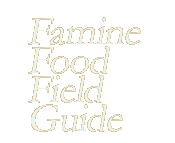Scientific
name
Lagenaria
siceraria1 (Molina) Standley
Local name(s)
Hera
(Konsogna) = Calabash seeds, Kula (Somali), Buge (Borena), Gourd, Bottle Gourd,
Calabash Gourd, Calabash (English)
General description
L.
siceraria
is a monoecious annual, long-trailing or climbing herb with divided tendrils.
Leaves are simple, kidney-shaped. Male flowers are solitary, borne on long
stalks, large, white axillary, with funnel-shaped tube, opening in the evening.
Female flowers have a short tube. The young fruits are softly hairy, variable in
colour from green, speckled to cream or pale yellow. Mature fruit has a dry,
usually brown, hard but little shell with a smooth or warty surface. Cultivated
forms are very variable in shape and size, 5-100cm or longer. The shape of the
fruit may vary from spindly to spherical with almost infinite intermediate
shapes - constricted, crescent-shaped, cylindrical, etc. Seeds are cream to
brown, compressed, embedded in a white spongy pulp. The size and shapes of
gourds is both genetically and environmentally determined. Flowers produced
first give rise to bigger gourds as the growth of the plant is vigorous.
Edible part(s),
preparation methods and palatability
In
Konso seeds are consumed. The seeds are dried in the sun and then roasted prior
to consumption. Furthermore the roasted seeds can be grinded to powder that is
used to produce a drink similar to coffee. But apart from the seeds L.
siceraria has many different comestible parts and uses. The young, tender
fruits of some small cultivars are eaten as a vegetable. The cooked fruit is soft, slightly sweet or almost without taste.
These 'sweet' types may be boiled, salted and eaten or boiled, mashed, fried and
made into a stew. Mature fruits turn somewhat bitter and are not used as food.
The seeds are edible and in some cultivars are high in protein and oil. Young
shoots and leaves of some cultivars are used as a leafy vegetable.
Agroecology
L.
siceraria
is believed to be of African origin and a traditional crop in many African
cultures. It is cultivated throughout the tropics and subtropics of both the Old
and the New World. The species is widely used especially for its fruits which
are mostly used as containers. The plant is often escaping to the wild and grows
from sea level to 2,800m, but is usually cultivated between sea level and
2,500m. The species grows in riverine and lakeshore conditions, in grassland and
bushland and is found on a wide range of soil types, but very common on
well-aerated fertile soils. It needs between 400 and 1,500mm of well-distributed
annual rainfall. And moisture is crucial during fruit growth since drought leads
to dropping of the immature fruit.
Propagation
method(s)
Gourd
plants grow easily from seeds. Seedlings require well-aerated fertile soils and
are planted during the rainy season.
Sample location(s)
Shagana
village, Jarso Kebele (?), Konso Special woreda
Remarks
Both
edible and inedible cultivars are cultivated for a wide range of uses depending
on their size and shape. The use of the gourd as a container is common in many
African cultures, farmers and pastoralists alike. When cut into halves the
various types, including the edible ones, find new uses as open containers used
for storage, lading out food, fluids, seeds, etc., and as a cup, bowl or plate.
Various
forms of gourds are sold, either as containers or in halves used as bowls or
ladles. The Hamer and Bena people use the calabash gourds cut in halves as a
head decoration and protection against the sun.
1 Parts
of the following description have been taken from Maundu et al., 1999: p.156
Back
to Top
|



